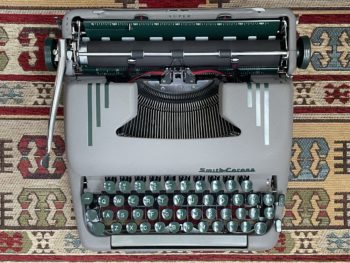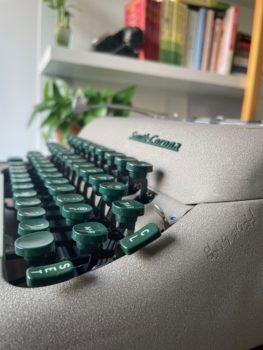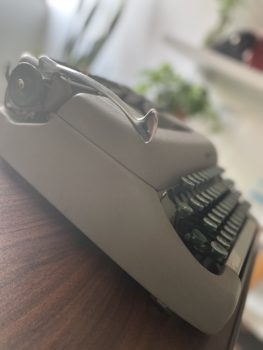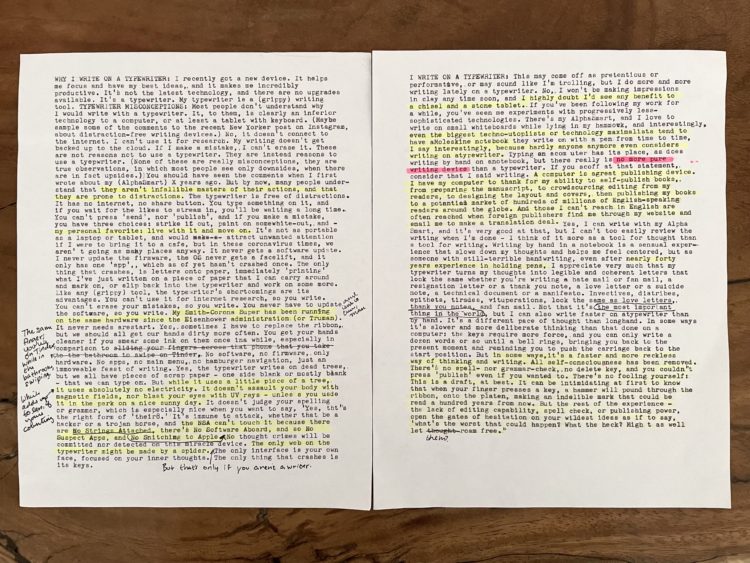Subscribe to blog updates via email »
Write on a Typewriter – Love Your Work, Episode 273
 It seems even the most devout techno-utopiasts carry around a Moleskine notebook. They appreciate the way writing longhand on paper alters their thought processes. Yet the same people think writing on a typewriter is absurd, performative, pretentious, or a deliberate troll.
It seems even the most devout techno-utopiasts carry around a Moleskine notebook. They appreciate the way writing longhand on paper alters their thought processes. Yet the same people think writing on a typewriter is absurd, performative, pretentious, or a deliberate troll.
Listen to the Podcast

WANT TO WRITE A BOOK?
Download your FREE copy of How to Write a Book »
(for a limited time)
- Listen in iTunes >>
- Download as an MP3 by right-clicking here and choosing “save as.”
- RSS feed for Love Your Work
Over the past year, I’ve grown to love writing on a typewriter. I didn’t write my first three books on a typewriter, but I am my next one. I use my typewriter to write articles (yes, this one), email newsletters, and even tweets.
I think you should try it. Write on a typewriter.
The typewriter is the best writing tool ever
If you’ve followed my work a while, you’ve seen me experiment with progressively more-primitive writing tools. I first used an AlphaSmart – a portable word-processor – seven years ago. Readers of my latest book, Mind Management, Not Time Management will recognize the typewriter as another “grippy” tool. It helps you get a grip on your thoughts, without letting them slip.

But, I think the typewriter is the end of this road. I won’t be making cuneiform impressions on clay any time soon, and I won’t even bother experimenting with a chisel and stone tablet.
As the musician John Mayer – who writes his lyrics on a typewriter – has said, “I’m not picking the typewriter because I think it’s hip. It’s the best version of the idea that’s ever come around.” Or, as I say, there is no more pure writing device than a typewriter.
Before you dismiss that statement, think about it carefully. Notice I said “writing,” not “editing,” nor “publishing.”
Computers are great for publishing
A computer is the greatest publishing device ever. I have a computer to thank for my career as an author. It not only helps me lay out the interiors of my books and design my covers, but without my computer, I couldn’t then publish my books to a market of hundreds of millions of readers around the globe.
None of it could be done without my computer. And since my computer is also what I use to crowdsource editing from my readers and prepare manuscripts, the computer is not only the best publishing device, it’s the best editing device.

Typewriters are great for writing
Write, edit, publish: Those are the steps you must repeat to be a writer, and they have to be done in order. You can take a step backward, but you can’t skip a step forward. No device does the first step better than a typewriter.
It’s for writing, not research
Some will protest that you can’t look things up on a typewriter. Well, that’s “research,” and it can be done before writing, or after writing, while editing. Research, however, is not writing. Only writing is writing.
Your first draft doesn’t belong on the cloud
Some will point out that when you write on a typewriter, your work isn’t stored on a hard drive or backed up to the cloud. It’s too easy to lose sheets of paper. These people fundamentally misunderstand the writing process.
As Ernest Hemingway said, “The first draft of anything is shit.” The typewriter is where you say everything you might want to say and explore how to say it. While it shows up on a page, the real work takes place in your mind – daydreamt in your own personal cloud.
As you write, you print
Not that your first draft isn’t handy to have. This makes the typewriter the better writing device than its cousin, the AlphaSmart. The AlphaSmart has a tiny screen, which is a good forcing-function to keep your fingers moving. But once the writing is done, you mostly have to rely on what new connections you’ve made in your mind. As you write on a typewriter, you also print. When you’re done, you have a page you can pick up and mark on while you pace around or read parts aloud.
By the way, if you’re thinking that piece of paper is bad for the environment, consider that one hour of computer use is worth about seven sheets of paper. We all have scrap paper lying around with a bare side we can type on. You can save that from a landfill – and a typewriter, too!
When you write longhand on paper, you also get something tactile you can review. That is, if you have great penmanship. I, for one, still have illegible handwriting, even after forty years experience holding a pencil. I love how no matter what you write on a typewriter, it always looks the same: Invectives, tirades, and vituperations are printed with the same font as love letters, manifestos, and fan mail. The shapes of the letters impart no meaning, leaving only the words to do their jobs.
Typewriters are faster than longhand
As someone who wrote a book about how time management is overrated, I have to admit, it isn’t the most important thing in the world that you can write faster on a typewriter than by hand. The way longhand writing slows down your thought process has its place – as does the nimble qualities of writing on a computer in those rare cases where you merely need to record something you’ve already thought through.
A typewriter sits right in the sweet spot between speed and deliberation. The keys require more force than those of a computer, and you can only write a dozen words or so before a bell rings, bringing you back to the present moment and reminding you to push the carriage to the start position.

Typewriters are tools for thought
The typewriter is the best writing tool, which makes it a great thinking tool. This is less about what the typewriter makes you think and more about what the typewriter doesn’t make you think.
When I wrote about my AlphaSmart seven years ago, I was bombarded with comments about how it was weak to want a device that didn’t connect to the internet. If I wanted to avoid distraction, I should just suck it up and focus – at best disconnect my laptop from the internet.
By now, more people have realized they aren’t infallible masters of their actions, and are prone to distractions, and are looking for distraction-free writing tools. So, the first thing people usually appreciate about the typewriter is that it will prevent them from checking email or their favorite social media vice. The only web you’ll find on a typewriter might be made by a spider, but you’ll only have those if you aren’t a writer.
Typewriters are great for what they don’t have
The typewriter has no software and no firmware – it only has hardware. This means not a single software-update notification. My Smith-Corona has been running on the same hardware since the Truman administration.

And isn’t it true, man, those annoying software updates, while they promise to improve the interface, are really for security? The typewriter is immune to attacks and hacks. And the NSA can’t touch it because there’s No Software Aboard, and so No Suspect Apps, thus No Snitching to Apple. No thought crimes will be committed on the typewriter. You can write your thoughts, No Strings Attached.
You don’t get lost on a typewriter. There’s no main menu, no hamburger navigation, no apps to sample – just a writing feast. The only thing that crashes are the keys.
Since the typewriter lacks modern features such as the internet or software, that means no spelling- or grammar-check. If you make a mistake, you have three choices: strike it out, paint on whiteout (if you can still find some), or my personal favorite: live with it and move on.
There’s no fooling yourself when writing on a typewriter: This is a first draft. It will not be televised. Do not collect 200 edits. You can only pass “Go.”
Digital Zettelkasten now on Audible!
New Audible users listen free through this link. Also available on other platforms.
Join the Patreon for (new) bonus content!
I've been adding lots of new content to Patreon. Join the Patreon »
Subscribe to Love Your Work
Listen to the Podcast
- Listen in iTunes >>
- Download as an MP3 by right-clicking here and choosing “save as.”
- RSS feed for Love Your Work
Theme music: Dorena “At Sea”, from the album About Everything And More. By Arrangement with Deep Elm Records. Listen on Spotify »



